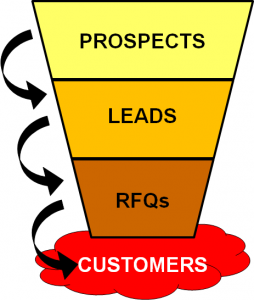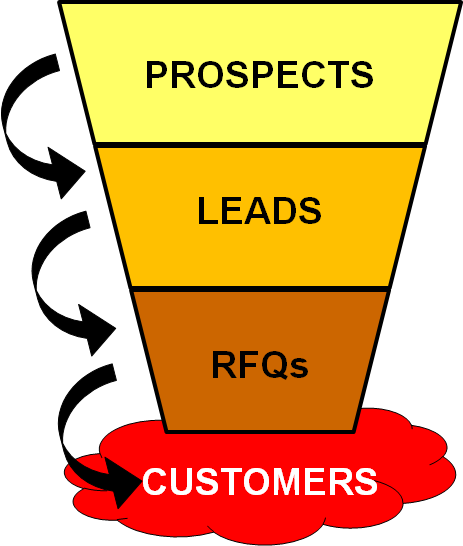You read that right – this is about Sales Headlights not Sales Highlights. Tracking Sales performance is an area of the business filled with numbers you can highlight. Like baseball, you can watch your team’s overall win/loss record, your team’s batting average (wins as a percent of quotes), and the same for individual salespeople on your team.
As helpful as those stats may be, if you think about them, they all track past performance. Granted, past performance is often a good indicator of future performance, but how does that help you as a manager in running your company? Do past sales indicate future sales? Do past sales help plan upcoming work schedules?
What’s needed is a sales indicator that looks through the windshield with high-beam headlights even, to look as far ahead as possible for future sales, instead of looking through the rear-view mirror at sales reports then scratching your head wondering why sales goals aren’t being met. If we can shine a light on that deep, dark area of future sales, we have far better insight into upcoming challenges that will affect everyone in the company.
Sales Through the Windshield
Before counting a sale – whether to a current or new customer, the sales team performs a series of activities that lead to that sale.
For most small & medium-size companies, your Sales Team spends a significant amount of time quoting in response to RFQs. Quoting done right is time-consuming; most companies track #quotes and $quoted regularly. This offers some view ahead of a sale – but is usually close to the sale.
Prior to earning an RFQ and the “right” to quote, salespeople identify and make contact with New Prospects, then dedicate time to developing them into Leads for potential new business. To grow a company’s customer base, an investment is required in Sales time to identify Prospects and develop Leads.
This “future business pipeline,” holds the key for identifying future sales. For example, a $10Mil company trying to grow to $12Mil requires $1Mil sales revenue each month on average to meet the goal. If there is $1Mil new potential business in the Lead Pipeline, and it takes 3 months on average for a Lead to convert to an RFQ – the company has an insufficient Lead Pipeline to achieve its sales goal.
In other words, building and tracking a Lead Pipeline – including #Prospects, #Leads, $Leads, $Quotes – enables a forward view of Sales. It helps identify things like –
- Do we have enough Leads in the pipeline?
- Are they the right Leads?
- What can we do to generate more Prospects?
- What activities motivate Prospects to become Leads?
- Where should we focus our time & resources?
Lead Generation is a Core Process
Lead Generation is an integrated sales & marketing approach to reaching out to new potential customers. It helps build the future sales funnel with two outcomes –
- Build #Prospects by creating AWARENESS for your company – helping to get your name out to target companies and contacts about your firm’s name & capabilities
- Build #Leads by providing PROOF of how your firm uniquely solves challenges commonly found among your target companies – so when people at these target companies face a challenge you can solve, they think of your firm first and inquire – by phone, e-mail or website “Contact Us”
Bottom line: Lead Generation done right creates a more efficient, more productive Sales activity. It helps build a Lead Pipeline – enabling your Sales Team to focus on value-added activities like building customer relationships and Quoting, versus the inefficient activity of cold-calling unknown prospects.
Successful Lead Generation uses the company Website as the “mission central” single point of truth, driving new and more traffic to your website than otherwise. Those who view the website and submit “inquiries” are considered Leads. They likely have a specific challenge that motivated taking extra time to fill out the website “Contact Us” form.
Using the Lead Pipeline as a tool in Sales and Management meetings allows a forward view through the windshield of future sales, prioritizing activities to insure sales goals are achieved before looking at sales reports and asking “Why didn’t we meet our goal this month?”
Building and tracking the Lead Pipeline is the best means of forecasting future sales, prioritizing which leads to focus time and resources toward, and eliminating surprises when the sales report comes out, your goal is missed, and it’s too late to make up for lost time.
Growth GPS Provides Lead Generation Assistance
Growth GPS helps small and medium-size firms with Lead Generation activities. This includes:
- Website Development, including enhancing current website effectiveness and building new websites;
- Lead Generation Training, including custom toolset build and campaign development;
- Lead Generation Campaign Implementation, developing and implementing campaigns to reach additional customers in current or new markets;
- Lead Generation Metrics, best practices for measuring campaign impact and refining future campaigns to enhance impact;
- Lead Generation Sustain Process, developing a custom process to continue Lead Generation activities and measurement using internal company resources.



